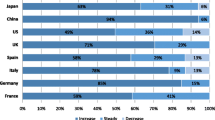Abstract
Purpose
This study aimed to determine the current percentage of United States (U.S.) assisted reproductive technology (ART) clinics offering sex selection via pre-implantation genetic screening (PGS) for non-medical purposes.
Methods
The authors conducted website review and telephone interview survey of 493 U.S. ART clinics performing in vitro fertilization (IVF) in 2017. Main outcome measures were pre-implantation genetic screening (PGS)/pre-implantation genetic diagnosis (PGD) practices and non-medical sex selection practices including family balancing.
Results
Of the 493 ART clinics in the USA, 482 clinics (97.8%) responded to our telephone interview survey. Among all U.S. ART clinics, 91.9% (n = 449) reported offering PGS and/or PGD. Furthermore, 476 clinics responded to survey questions about sex selection practices. Of those ART clinics, 72.7% (n = 346) reported offering sex selection. More specifically among those clinics offering sex selection, 93.6% (n = 324) reported performing sex selection for family balancing, and 81.2% (n = 281) reported performing for elective purposes (patient preference, regardless of rationale for the request). For couples without infertility, 83.5% (n = 289) of clinics offer sex selection for family balancing and 74.6% (n = 258) for non-specific elective reasons.
Conclusions
The majority of U.S. ART clinics offer non-medical sex selection, a percentage that has increased substantially since last reported in 2006.

Similar content being viewed by others
References
Baruch S, Kaufman D, Hudson KL. Genetic testing of embryos: practices and perspectives of US in vitro fertilization clinics. Fertil Steril. 2008;89:1053–8.
Hens K, Dondorp WJ, Geraedts JP, de Wert GM. Comprehensive embryo testing: experts' opinions regarding future directions: an expert panel study on comprehensive embryo testing. Hum Reprod. 2013;28:1418–25.
Mastenbroek S, Twisk M, van Echten-Arends J, Sikkema-Raddatz B, Korevaar JC, Verhoeve HR, et al. In vitro fertilization with preimplantation genetic screening. N Engl J Med. 2007;357:9–17.
Ethics Committee of the American Society for Reproductive Medicine. Use of reproductive technology for sex selection for nonmedical reasons. Fertil Steril. 2015;103:1418–22.
Committee on Ethics American College of Obstetricians, Gynecologists. ACOG committee opinion no. 360: sex selection. Obstet Gynecol. 2007;109:475–8.
Centers for Disease Control and Prevention, American Society for Reproductive Medicine, Society for Assisted Reproductive Technology. 2015 fertility clinic success rates report: data clinic tables and data dictionary. Atlanta: US Dept of Health and Human Services; 2017.
Centers for Disease Control and Prevention, American Society for Reproductive Medicine, Society for Assisted Reproductive Technology. 2014 assisted reproductive technology fertility clinic success rates report. Atlanta: US Dept of Health and Human Services; 2016. Report No.: GS-23F-8144H.
Fertility Authority. Fertility Clinics by State. New York: Progyny Inc.; 2017. Available at: https://www.fertilityauthority.com/clinics/bystate. Accessed 15 June 2017.
Infertility Resources. Lafayette: Internet Health Resources Company; 1996–2017. Available at: http://www.ihr.com/infertility/provider/fertility-ivf-clinics.html. Accessed 17 June 2017.
Society for Assisted Reproductive Technology. Preliminary Clinic Summary Report. 2015. Available at: https://www.sartcorsonline.com/rptCSR_PublicMultYear.aspx?reportingYear=2015. Accessed 25 June 2017.
U.S. Census Bureau. Geographic areas reference manual. 1994. Available at: https://www.census.gov/geo/reference/garm.html. Accessed 15 June 2017.
U.S. Census Bureau. 2010 Census Urban and Rural Classification and Urban Area Criteria. Available at: https://www.census.gov/geo/reference/ua/urban-rural-2010.html. Accessed 15 June 2017.
U.S. Census Bureau. Census 2000 Urban and Rural Classification. Available at: https://www.census.gov/geo/reference/ua/urban-rural-2000.html. Accessed 15 June 2017.
Census Viewer. Census 2010 and 2000 Interactive Maps, Demographics, Statistics, Quick Facts. Eugene: Moonshadow Mobile Inc.; 2016. Available at: http://censusviewer.com/free-maps-and-data-links/. Accessed 2 Aug 2017.
Census.gov. Geography atlas: regions. Washington: United States Census Bureau. Available at: https://www.census.gov/geo/reference/webatlas/regions.html. Accessed 25 June 2017.
Author information
Authors and Affiliations
Corresponding author
Ethics declarations
Conflict of interest
The authors declare that they have no conflict of interest.
Rights and permissions
About this article
Cite this article
Capelouto, S.M., Archer, S.R., Morris, J.R. et al. Sex selection for non-medical indications: a survey of current pre-implantation genetic screening practices among U.S. ART clinics. J Assist Reprod Genet 35, 409–416 (2018). https://doi.org/10.1007/s10815-017-1076-2
Received:
Accepted:
Published:
Issue Date:
DOI: https://doi.org/10.1007/s10815-017-1076-2




